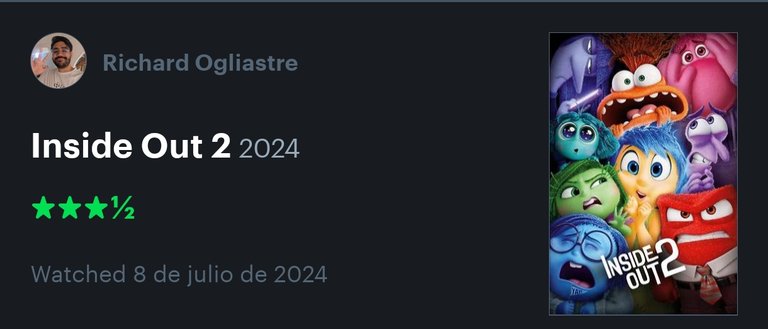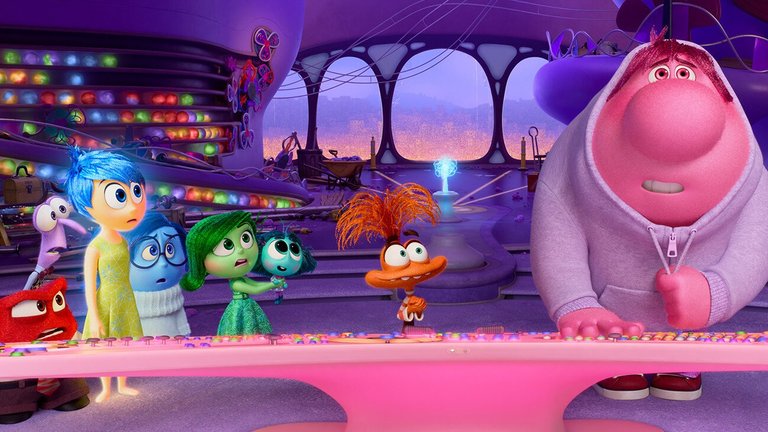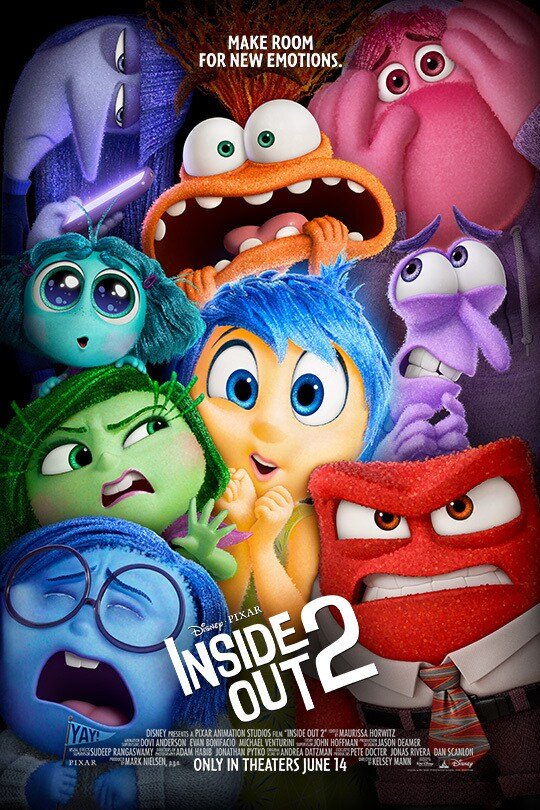A logical sequel - Inside Out 2.

ENGLISH
Although Inside Out has never been one of my favorite Pixar films, I must admit that at least in terms of execution, it is one of their most interesting films, something particularly striking considering that their catalog over the last decade has lost a bit of consistency (At least if we compare it to its golden era in the early 2000s).
Although on paper it sounds like just another ordinary movie, there are an infinite amount of creative possibilities with its premise: What would happen if our emotions had life and took control of all our decisions?
On that occasion, we followed the story of Riley, an exemplary girl who had to deal with a regrettable change in her life when her parents decided it was time to move to another city.
Meanwhile, we watched as Joy, Sadness, Disgust, Fury and Fear struggled to direct Riley, something that essentially served as a simple but effective metaphor to explain to the youngest members of the house how complicated it can be to manage our own emotions. . , as well as embracing that sadness is a crucial part of our development and therefore should not always be seen as something negative.
Beyond this, Inside Out had brilliant world building, which tried to give an explanation to everything that makes us human: our dreams, our memories, our social connections, etc.
The complicated thing about a franchise like this (Which, as I mentioned previously, has a clear didactic focus for children and adults), is that unlike a traditional sequel, creating a continuation is not as easy as taking the same premise and elevating what there is. at stake, since first: it would be redundant, and second: considering the importance that sadness had in the first film, it would also be extremely depressing.
The solution is simple, instead of addressing sadness again as the main focus, we focus on a new emotion, a characteristic emotion of adolescence, also allowing Riley's character to grow: anxiety.
This approach to its own universe and internal regulations justifies the entire existence of Inside Out 2, a film that naturally turns out to be less "sad", but that maintains the level of forcefulness that we expect.
Is it predictable? Yes, especially because we know (thanks to the first film) that the priority is not so much to tell a structurally satisfactory story, but rather to land a psychological lesson effectively.
Inside Out 2 perfectly represents the complexity of adolescence, with all its ups and downs, while maintaining the excellent level of production that we only expect from a Pixar film in 2024.
At the same time, it leaves some seeds that could eventually be exploited in a hypothetical third party, something that personally wouldn't bother me.

Score taken from my Letterboxd account.


ESPAÑOL
Aunque Inside Out nunca ha sido una de mis películas favoritas de Pixar, debo admitir que al menos en términos de ejecución, resulta uno de sus filmes más interesantes, algo particularmente llamativo tomando en cuenta que su catálogo durante la última década ha perdido un poco de consistencia (Al menos si lo comparamos con su era dorada a principios de los 2000).
Aunque en papel suena como una película más del montón, existen una infinita cantidad de posibilidades creativas con su premisa: ¿Que pasaría si nuestras emociones tuvieran vida y tomaran el control de todas nuestras decisiones?
En esa ocasión, seguíamos la historia de Riley, una chica ejemplar que debía lidiar con un cambio repentino en su vida cuando sus padres decidieron que era el momento de mudarse de ciudad.
Mientras tanto, nosotros observamos como Alegría, Tristeza, Desagrado, Furia y Miedo luchaban por dirigir a Riley, algo que en esencia servía como una simple pero efectiva metáfora para explicarle a los mas jóvenes de la casa lo complicado que puede ser manejar nuestras propias emociones, así como abrazar que la tristeza es una parte crucial de nuestro desarrollo y por ende no siempre debe ser vista como algo negativo.
Más allá de esto, Inside Out contaba con un world building brillante, que trataba de darle una explicación a todo aquello que nos hace ser humanos: nuestros sueños, nuestras memorias, nuestras conexiones sociales, etc.
Lo complicado de una franquicia como esta (Que como mencioné previamente, tiene un claro enfoque didáctico para niños y adultos), es que a diferencia de una secuela tradicional, crear una continuación no es tan fácil como tomar la misma premisa y elevar lo que hay en juego, ya que primero: resultaría redundante, y segundo: considerando la importancia que tuvo la tristeza en el primer film, también sería extremadamente deprimente.
La solución es sencilla, en vez de abordar la tristeza otra vez como foco principal, nos enfocamos en una emoción nueva, una emoción característica de la adolescencia, permitiendo que aparte el personaje de Riley pueda crecer: la ansiedad.
Este acercamiento a su propio universo y reglamento interno justifica por si solo la existencia entera de Inside Out 2, una película que naturalmente resulta menos "triste", pero que mantiene el nivel de contundencia que esperamos.
¿Es predecible? Si, especialmente porque sabemos (gracias al primer film) que la prioridad no es tanto narrar una historia estructuralmente satisfactoria, sino más bien hacer aterrizar una lección psicológica con efectividad.
Inside Out 2 representa a la perfección la complejidad de la adolescencia, con todas sus altos y sus bajos, manteniendo al mismo tiempo el excelente nivel de producción que solemos esperar de una película de Pixar en pleno 2024.
Al mismo tiempo, deja algunas semillas que podrán ser explotadas eventualmente en una hipotética tercera parte, algo que personalmente no me molestaría.

Puntaje sacado de mi cuenta de letterboxd.

Twitter/Instagram/Letterbox: Alxxssss


